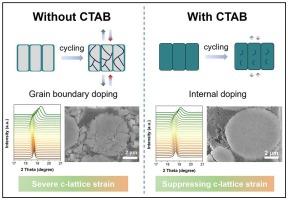抗应变无co高镍LiNi0.9Mn0.1O2阴极初晶中掺杂高价掺杂剂的研究
IF 22
1区 材料科学
Q1 MATERIALS SCIENCE, MULTIDISCIPLINARY
引用次数: 0
摘要
无钴高镍正极材料具有高能量密度和低成本等优点,但由于循环过程中c晶格的严重畸变,其循环寿命不理想。在现有的掺杂策略中,电荷不平衡和与Ni3+的离子尺寸差异阻止了高价掺杂剂在煅烧过程中进入初级颗粒,从而限制了它们抑制晶格应变的能力。在这项研究中,我们采用了一种新的掺杂策略,在共沉淀过程中利用有机表面活性剂将Zr4+离子均匀地定位在LiNi0.9Mn0.1O2的初级颗粒中。Zr4+离子位于原生粒子内,发挥柱效应,显著增强了材料的结构坚固性。在第一次循环中,c晶格收缩减小,有效地抑制了颗粒中微裂纹的形成。结果表明,经过100次循环后,其容量保持率显著提高至98.6% (189.2 mAh g−1)。本文章由计算机程序翻译,如有差异,请以英文原文为准。

Incorporation of high-valence dopants in primary particles for strain-resistive Co-free high-Ni LiNi0.9Mn0.1O2 cathodes
Co-free high-Ni cathode materials, which offer advantages such as high energy density and low cost, exhibit unsatisfactory cyclic life due to severe c-lattice distortion during cycling. In existing doping strategies, charge imbalance and ionic size differences with Ni3+ prevent the incorporation of high-valence dopants into primary particles during the calcination, thereby limiting their ability to suppress lattice strain. In this study, we employ a new doping strategy utilizing organic surfactants during the co-precipitation process to homogeneously position Zr4+ ions within the primary particles of LiNi0.9Mn0.1O2. Zr4+ ions located within the primary particles exerted a pillar effect, significantly enhancing the structural robustness of the material. During the first cycle, the c-lattice contraction is reduced, effectively inhibiting microcrack formation in the particles. As a result, it exhibits a significantly improved capacity retention of 98.6 % (189.2 mAh g−1) after 100 cycles.
求助全文
通过发布文献求助,成功后即可免费获取论文全文。
去求助
来源期刊

Materials Today
工程技术-材料科学:综合
CiteScore
36.30
自引率
1.20%
发文量
237
审稿时长
23 days
期刊介绍:
Materials Today is the leading journal in the Materials Today family, focusing on the latest and most impactful work in the materials science community. With a reputation for excellence in news and reviews, the journal has now expanded its coverage to include original research and aims to be at the forefront of the field.
We welcome comprehensive articles, short communications, and review articles from established leaders in the rapidly evolving fields of materials science and related disciplines. We strive to provide authors with rigorous peer review, fast publication, and maximum exposure for their work. While we only accept the most significant manuscripts, our speedy evaluation process ensures that there are no unnecessary publication delays.
 求助内容:
求助内容: 应助结果提醒方式:
应助结果提醒方式:


